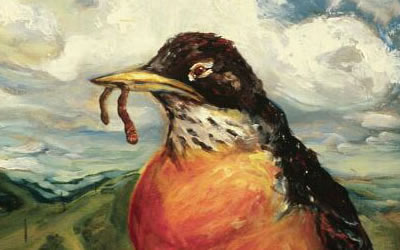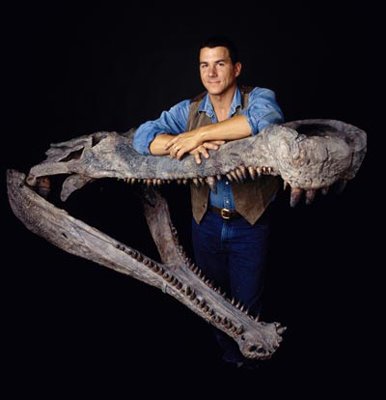In the previous posts in this series, I covered the circadian clocks in
Synechococcus, potential circadian clocks in a couple of other bacteria, and the presence of clock genes (thus potentially clocks) in a number of other bacteria. But what happened to the microbiological workhorse, the
Escherichia coli? Does it have a clock? Hasn't anyone checked?
Believe it or not, this question is colored by politics. But I have to give you a little background first. Latter half of the 19th and the first half of the 20th century saw a number of researchers discovering circadian rhythms independently from each other. They came from different backgrounds and did research in a variety of questions in different organisms. There were botanists and entomologists, physiologists and ecologists, behavioral biologists and microbiologists, evolutionary biologists and physicians.
The
founding moment of the field was the Cold Spring Harbour meeting in 1960, which produced the Proceedings (Cold Spring Harbor Symposia on Quantitative Biology: Volume XXV. Biological Clocks. New York: Cold Spring Harbor Press, 1960.) which is, arguably, the founding document of the field. It is there and then that everyone realized that they were all studying the same phenomenon, they agreed on common terminology, and learned from each other what became standard experimantal methods in the field.
Not much later, in the 1970s, the
Society for Research in Biological Rhythms (SRBR) was formed and had its first meeting. Apart from wonderful talks and posters, and rambunctious partying, one of the key moments of the meeting was the election of the Society President. By that time, something akin to War of the Roses was going on in the field. The two candidates for the position were the leaders of the two factions.
One faction, led by Franz Halberg (who coined the term "circadian" among else), was medically minded and argued for a practical, applied approach to the study of rhythmic phenomena, coupling mathematical modelling with clinical studies in humans and some model animals like rats and mice. The other faction, led by Colin Pittendrigh (student of Theodozius Dobzhansky), came from an evolutionary, ecological and ethological tradition, arguing for an integrative and comparative approach to the study of the basic science of biological rhythms.
Fortunately for all, Pittendrigh won. The rest is history - chronobiology took off and nobody could stop its meteoric rise. The human/medical approach that plagued the sleep research for so many decades
was avoided by chronobiology. But the bad blood between Pittendrighians and the Halbergians remained for a long time - it actually still simmers underneath the surface, especially among the seniors in the field. Most of the top researchers in the field, the meeting organizers, the Society officials, textbook writers, journal editors, and the plenary lecture speakers are Pittendrigh's academic children, grandchildren and great-grandchildren (OK, I am one, too).
When I mentioned, in the
first post in this series, that it was believed for decades that bacteria had no clocks, I was just parroting the party line. But there were some people who thought otherwise all along. Here is what Franz Halberg himself says about the question of clocks in
Echerichia coli:
A circadian rhythm in bacteria was documented time-microscopically in 1961 on impeccable data collected by Lore A. Rogers (a noted bacteriologist described by a Cosmos Club Vignette of December 1967 as "the bright star in the [U.S. Department of Agriculture's] scientific horizon before World War II"). Rogers' data stemmed from a fluid culture of E. coli, analyzed both by a periodogram and by power spectra, showing clear free-running circadians. Nonetheless, for years international symposia and cell chronobiologists in particular, including a committee formed by them in 1975, held the view that circadians are a property only of eukaryotes. I wrote to each committee member asking why they ignored the demonstration in E. coli and the extension of the finding by Sturtevant in John Pauly's laboratory in Arkansas. I regarded, and continue to regard the organizers as friends. Both Woody Hastings and the late Hans-Georg Schweiger thereafter extended their focus to circaseptans, documenting their open mind. Schweiger became a visiting professor at the University of Minnesota and was my house guest (and I his house and institute guest), and in later years cooperated extremely closely. A friend on the committee, however, wrote that he "ate crow" and noted that the "consensus" had been that there were "too many analyses" in the 1961 publication and again too much time-microscopy in the follow-up study, a thesis notwithstanding. The consensus was also in keeping with negative unpublished results by several symposium participants; so went the critique leading to the committee's decree that circadians are limited to eukaryotes. Jürgen Aschoff also responded by asking something like "Do you wish to hold us responsible for posterity?" I answered in a qualified affirmative, that the rules we postulate today may be revised tomorrow, always based on data. Microbial circadians abound today and constitute an active field of investigation.[1]
Ah, how diplomatically he had to put it for publication!
Well, I dug through Google Scholar, then through ISI Web of Science, and none of the papers Halberg mentions (see below) exist online - they are just too old. So, I cannot tell you now what I think about this question. Perhaps one day I'll be idle and have a lot of time and will dig out and photocopy the hardcopies of these papers at the library and check the data myself. For now, let's keep the question open.
Perhaps the 1930 data were nice and clear, while 1970s data not so because of decades of relaxed selection for rhythmicity in laboratory cultures of
E.coli held in acyclic conditions in the incubators. Perhaps they just lost rhythms during the intervening four decades. A new test should, perhaps, be performed on fresh wild-caught
Escherichia coli.
At least we know that short-period cycles can evolve in
E.coli under artifical selection [7], so, even if they do not naturally have circadian clocks, we can make them evolve one and solve the political problem once and for all.
[1] Franz Halberg et al.
Transdisciplinary unifying implications of circadian findings in the 1950s. Journal of Circadian Rhythms 2003, 1:2
[2] Halberg F, Conner RL: Circadian organization and microbiology: Variance spectra and a periodogram on behavior of Escherichia coli growing in fluid culture. Proc minn Acad Sci 1961, 29:227-239.
[3] Rogers LA, Greenbank GR: The intermittent growth of bacterial cultures. J Bacteriol 1930, 19:181-190.
[4] Halberg F, Cornélissen G: The spectrum of rhythms in microorganisms revisited. Chronobiologia 1991, 18:114.
[5] Sturtevant R: Circadian patterns in linear growth of Escherichia coli. Anat Rec 1973, 175:453.
[6] Sturtevant R: Circadian variability in Klebsiella demonstrated by cosinor analysis. Int J Chronobiol 1973, 1:141-146.
[7] Michael B. Elowitz and Stanislas Leibler, A synthetic oscillatory network of transcriptional regulators. Nature 403, 335-338 (20 January 2000)
Previously in this series:
Circadian Clocks in MicroorganismsClocks in Bacteria I: Synechococcus elongatusClocks in Bacteria II: Adaptive Function of Clocks in CyanobacteriaClocks in Bacteria III: Evolution of Clocks in CyanobacteriaClocks in Bacteria IV: Clocks in other bacteria
 (Image stolen from Xtinpore)
(Image stolen from Xtinpore)








